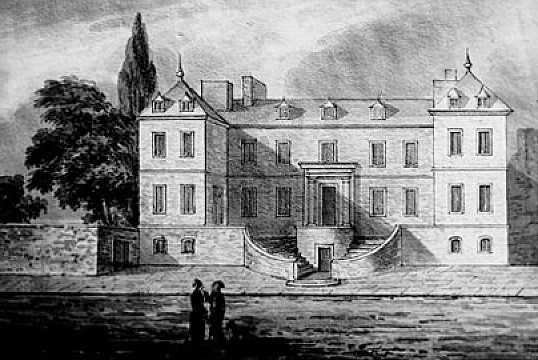Chateau de Vaudreuil
Place Jacques-Cartier, Montreal, Quebec
Completed in 1726, as the private residence of the Governor-General of New France, Philippe, Marquis de Vaudreuil (1643-1725) and his wife Louise-Élisabeth de Joybert (1673-1740). It was designed by the King's Engineer, Gaspard-Joseph Chaussegros de Léry. Though the Château Saint-Louis in Quebec City remained the official residence of the Governors-General of New France, the Château Vaudreuil was their official home in Montreal up until the British Conquest in 1763. It was home to the Marquis de Lotbinière and the Collège Saint-Raphaël before being lost to fire in 1803....

This house is best associated with...

Philippe de Rigaud de Vaudreuil
Philippe de Rigaud, Marquis de Vaudreuil; Governor-General of New France
1643-1725

Pierre de Rigaud de Vaudreuil
Marquis de Vaudreuil-Cavagnial; Last Governor-General of New France
1698-1778
Under the foundation stone a leaden plate stamped with three fleurs-de-lys was found bearing an inscription in French that translates to: "This stone was laid by Lady Louise Elyzabeth de Joybert, wife of the high and powerful Seigneur Philippe de Rigaud, Chevalier, Marquis de Vaudreuil, Grand Cross Order of Saint Louis, Governor and Lieutenant-General to the King of all of New France in 1723, the 15th of March." The chateau took three years to build and was completed in the classical style of the French "Hôtel Particulier" by King Louis XV's chief engineer in New France, Gaspard-Joseph Chaussegros de Léry. The central building was flanked by two wings with two sets of semi-circular stairs leading up to a terrace and the main entrance. It stood beyond the end of Rue Saint-Paul which was kept clear of buildings on that side to afford the chateau a clear view over the river while formal gardens led up to Notre-Dame Street.
Before the American Revolution, the Marquis de Lotbinière was one of the largest landowners in North America with holdings that amounted to over 850,000-acres in Quebec and New York. His father's first cousin (Louise-Élisabeth de Joybert de Soulanges) was the wife of Philippe, Marquis de Vaudreuil, and as such the chateau was her home in Montreal. It was their son, the last Governor of New France, who sold the chateau to his cousin before returning to France after Montreal was surrendered to the British in 1763. Lotbinière was also the son-in-law of its architect, Gaspard-Joseph Chaussegros de Léry.
Lotbinière sold the chateau in 1773 when it became home to the College de St. Raphael, which subsequently became today's Collège de Montréal. Following the fire in 1803, a group of merchants led by Jean-Baptiste Durocher and Joseph Périnault, purchased the land on which it had stood and its gardens. On the condition that it would be used for public markets, they gave the government a small, oblong, strip of land (previously part of the chateau's formal gardens), which was first named "New Market Place" and from 1847 became known as Place Jacques-Cartier. This shrewd deal made by the merchants had the effect of increasing the value of the adjacent properties built around the 'square' which remained in private hands. In 1809, Nelson's Column was built by the citizens of Montreal (both French and English) on what had been part of the château's formal gardens.
Before the American Revolution, the Marquis de Lotbinière was one of the largest landowners in North America with holdings that amounted to over 850,000-acres in Quebec and New York. His father's first cousin (Louise-Élisabeth de Joybert de Soulanges) was the wife of Philippe, Marquis de Vaudreuil, and as such the chateau was her home in Montreal. It was their son, the last Governor of New France, who sold the chateau to his cousin before returning to France after Montreal was surrendered to the British in 1763. Lotbinière was also the son-in-law of its architect, Gaspard-Joseph Chaussegros de Léry.
Lotbinière sold the chateau in 1773 when it became home to the College de St. Raphael, which subsequently became today's Collège de Montréal. Following the fire in 1803, a group of merchants led by Jean-Baptiste Durocher and Joseph Périnault, purchased the land on which it had stood and its gardens. On the condition that it would be used for public markets, they gave the government a small, oblong, strip of land (previously part of the chateau's formal gardens), which was first named "New Market Place" and from 1847 became known as Place Jacques-Cartier. This shrewd deal made by the merchants had the effect of increasing the value of the adjacent properties built around the 'square' which remained in private hands. In 1809, Nelson's Column was built by the citizens of Montreal (both French and English) on what had been part of the château's formal gardens.
You May Also Like...
Categories
Share
Connections
Be the first to connect to this house. Connect to record your link to this house. or just to show you love it! Connect to Chateau de Vaudreuil →








